Why is the US still using a Nazi tall ship?
- Published
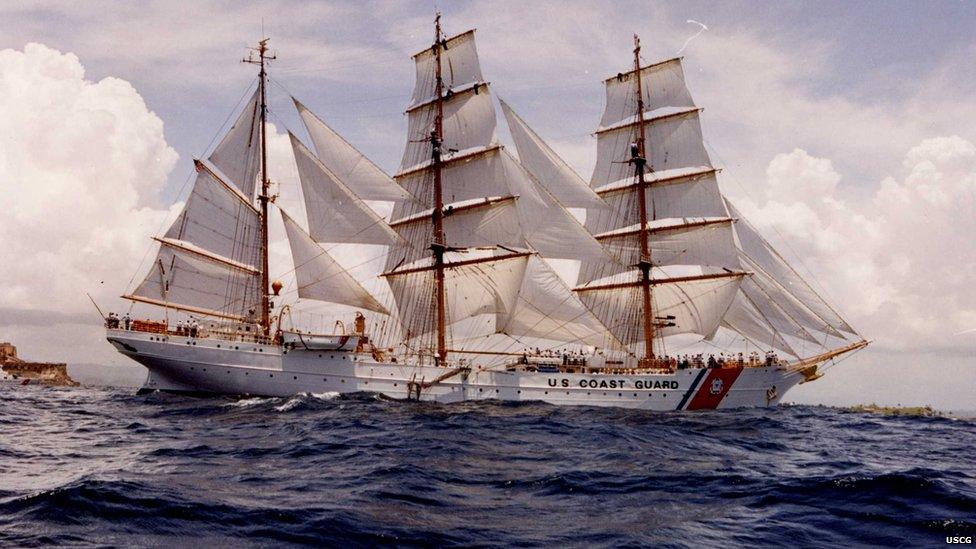
The Eagle was built by the Nazis and fought for Hitler in World War Two - so how did a tall ship that once flew the swastika end up as a training vessel for new US Coast Guard cadets?
Driving home along the coast of Connecticut one winter's evening, Tido Holtkamp saw a ghost.
There she was - moored in the harbour, her three towering masts, draped with those familiar sails he had rigged back in the German Navy in World War Two.
Her body had been repainted in the red, white and blue of the US, but her curves were unmistakable.
"That's my ship!" shouted Holtkamp, stopping the car. "That's my ship. The Horst Wessel. What in the world is she doing here in America?"
He may be 89 years old now, but the old sailor still twinkles wide-eyed as he recalls that moment back in 1959.
Tido Holtkamp remembers his time on the Eagle
We are sitting in the grand museum of the Coast Guard Academy in New London, Connecticut, not far from the place where the sight of the ship stopped Holtkamp in his tracks.
Above him hangs a carving of a gleaming golden eagle - the original German figurehead of his beloved vessel.
She is docked outside in the bay, with 150 young cadets preparing to jump aboard, climb the rigging and set sail for the Bahamas.
The Eagle is the flagship of the Coast Guard, and the only tall ship on active service in the US military.
Since 1946 every single new cadet undergoing officer training has begun his or her career by learning to sail on her - the old way.
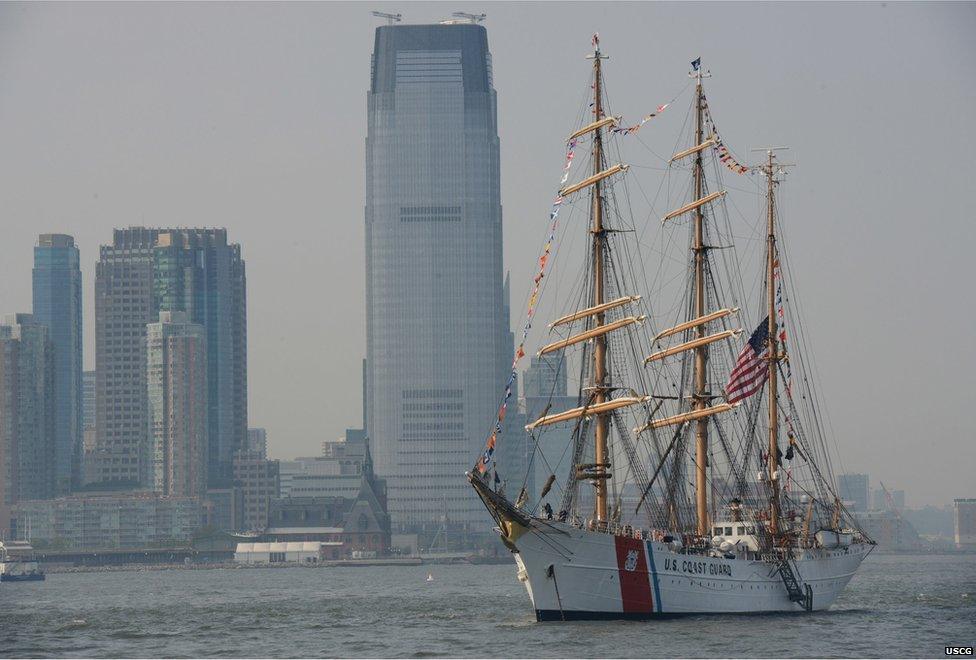

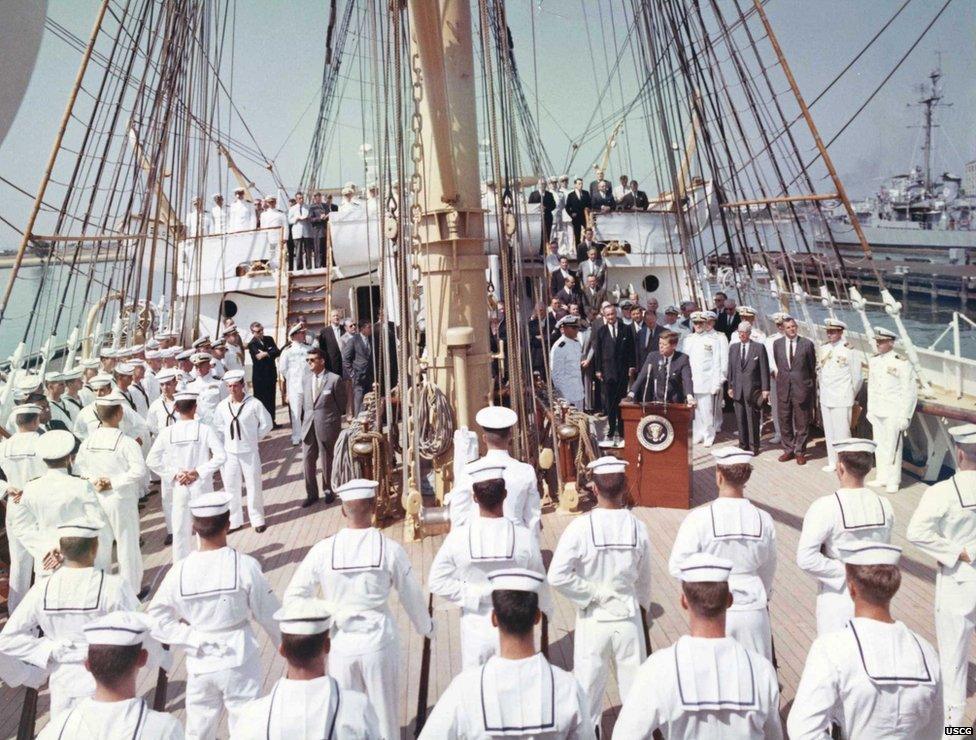
President Kennedy on board the Eagle
"It may look old-fashioned but the lessons you can learn about the sea and the wind and the currents and yourself - and your fellow shipmates - you cannot learn better on any platform that floats on the lakes or oceans around the world," says Capt Ernst Cummings, one of the ship's former US commanders.
The Eagle has hosted Presidents Kennedy, Nixon and Truman, and circumnavigated the globe as a kind of floating ambassador for US diplomatic relations.
But there is more to her history, a hidden story revealed by the German inscriptions concealed beneath a brass plate on the ship's wheel. And this is the story she shares with Holtkamp.
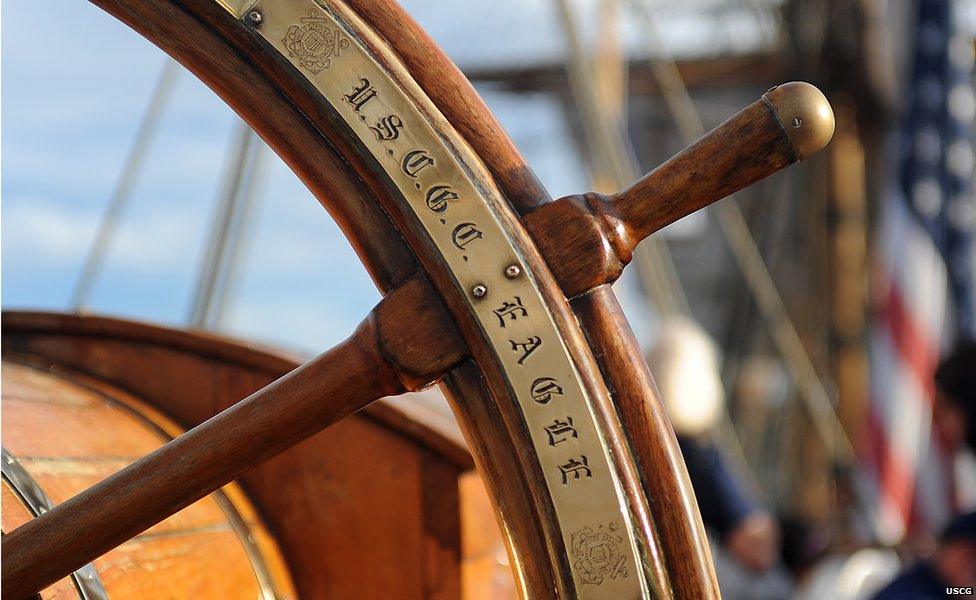
"Yes, the Eagle is an immigrant too - another immigrant that has done well," he says.
He points to the golden bird hovering above him: "You see that plate she holds in her talons? It's the US Coast Guard shield.
"But not when I sailed on her. The swastika was emblazoned there."
The ship now known as the Eagle was born in the world-famous shipyard of Blohm and Voss in Hamburg, the builders of the battleship Bismarck.
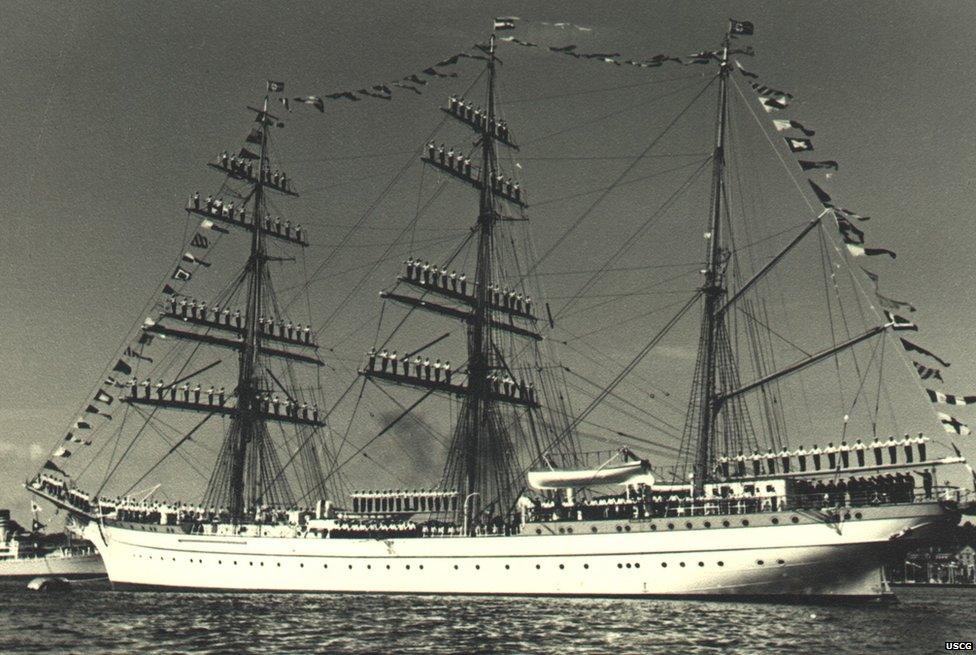
It was 1936, the Nazis were in power and their Kriegsmarine ("war navy") was growing fast.
To train sailors in the ways of the sea a magnificent barque was commissioned - the flagship of the training fleet.
Hitler was present at her launch and Rudolf Hess gave a speech. She was christened "Horst Wessel" after the storm trooper "hero" whose song Horst-Wessel-Lied became an anthem of the Third Reich.
The eagle on her prow was the Nazi Party's eagle, the Parteiadler.
"The Eagle is an emblem of force, strength and bravery - I'm not surprised it was chosen," says Holtkamp.
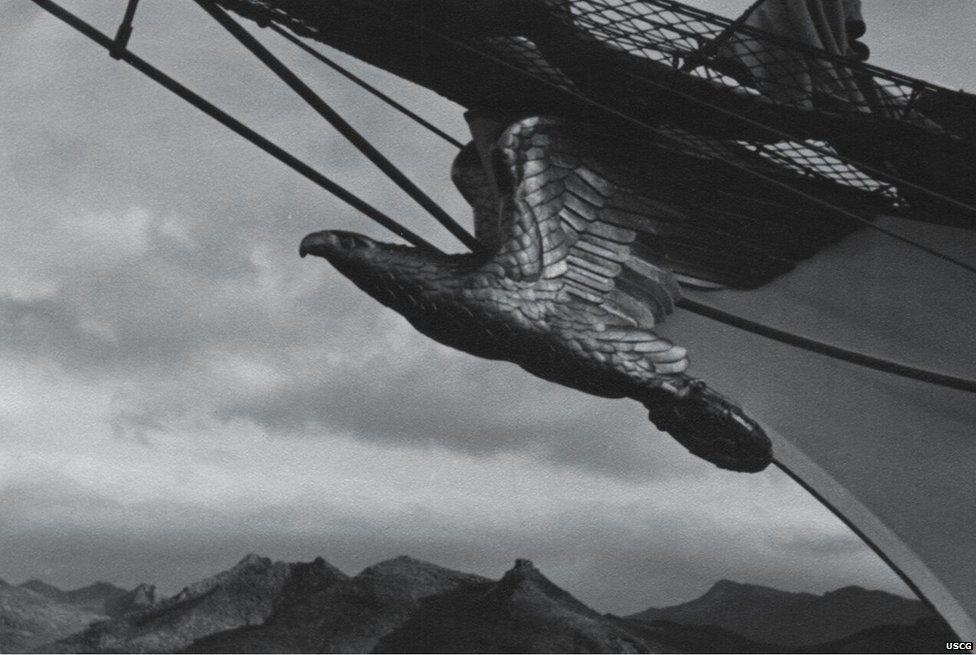

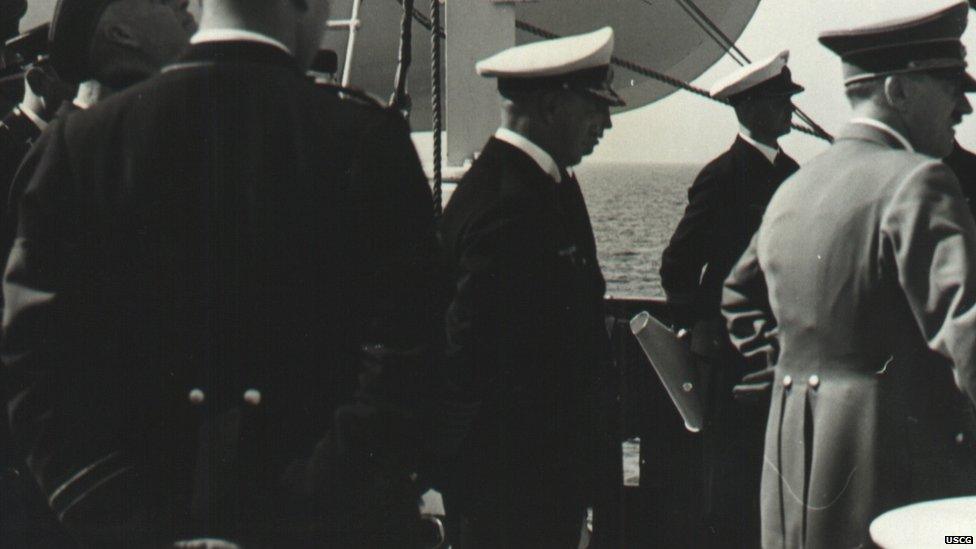
Hitler (right) only came on board once: "His boots had nails which scratched the deck but no-one dared question him', Holtkamp says.
When World War Two broke out in 1939, the cutter was initially kept in harbour to house a branch of the Hitler Youth.
But in 1942 - with the addition of anti-aircraft guns - she was commissioned for active service in the Baltic Sea.
A year later, in a small town near the German-Dutch border, a tall teenager named Holtkamp was preparing to be called up to the military.
"I was due to be drafted - probably into the army - and that meant the Eastern front," he recalls.
"Well I didn't want to go there, so I volunteered for the navy.
"We were all eagerly hoping to be on a small boat in the Mediterranean, maybe in Greece, with palm trees and beautiful girls. But most of us didn't get that."
Instead, Holtkamp found himself in the Baltic Sea port of Kiel staring at his new home - a training ship.
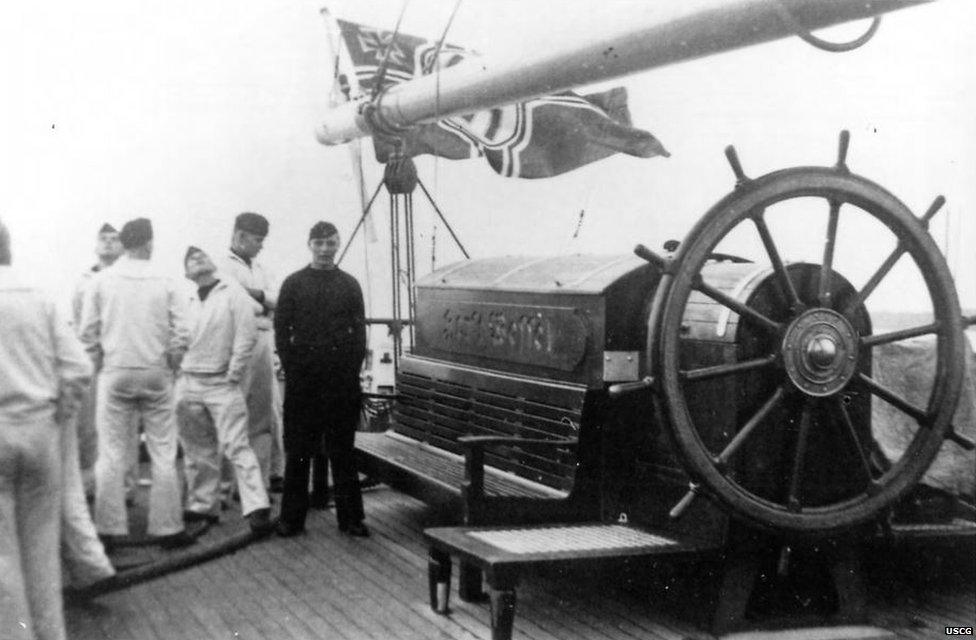

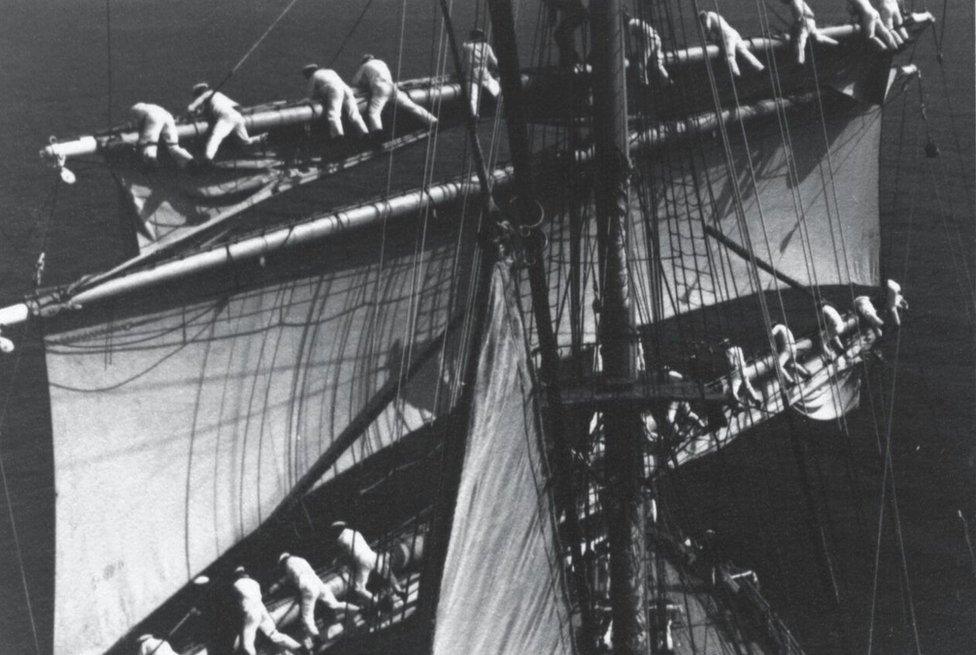
"When I first saw the ship it was colder than hell. I looked up that great tall mast and thought, 'My God in this weather I'm gonna go all the way up there?' I was scared.
"I was also disappointed. Horst Wessel was the only ship in the German Navy named after a Nazi - and even then we didn't want to be associated with anything Nazi-like."
Life on the boat was cramped - as it still is for today's young US cadets.
"We had hammocks back then. You would bounce into the guy next to you. But the camaraderie was fantastic.
"I loved the ship, the ocean, my buddies. I hated the discipline. We had an officer who was a real SOB - I never hated anybody in my life like this man. He was an SOB first class."
Holtkamp and his fellow recruits were put to work - rigging the sails, scrubbing the teak deck with holystone (a soft sandstone), polishing the brass, and taking watches - some of the very same jobs that cadets today are taught.
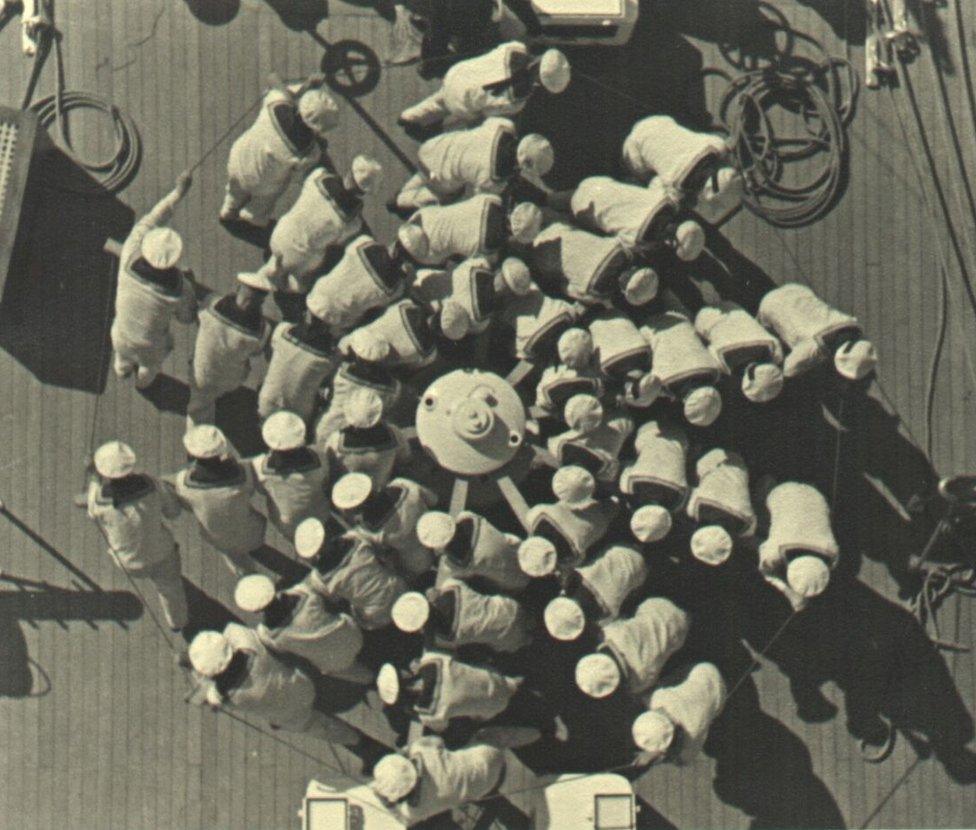
Raising the anchor by working the capstan
Meanwhile, overhead, they kept their eyes glued to the sky in fear. Every plane could be a Russian bomber. "And what would we do? We had guns installed but what good would they be?" he asks.
"Then one day I saw a formation coming over the harbour - American bombers with their bomb bays open. And we'd be a good hit - with 200 of us on board.
"I knew I couldn't leave the ship. So I watched as they dropped the bombs right next to us."
During a more peaceful spell in Danzig (now the Polish port of Gdansk) he had time to get acquainted with "forbidden" American records, which were still being played despite the war.
"St Louis Blues. Stormy Weather. Bei Mir Bistu Shein [an English-language song taken from a Yiddish comedy in New York]. All these songs I had never heard - I learned every one them.
"There was this fascination with Americans and the English - even through their bombing raids, that never ceased."
He didn't know it then but very soon Holtkamp would experience American and British culture from much closer range.
In April 1945 the British arrived, seized the Horst Wessel and hoisted the union jack. Holtkamp, meanwhile, was handed over to the Americans.
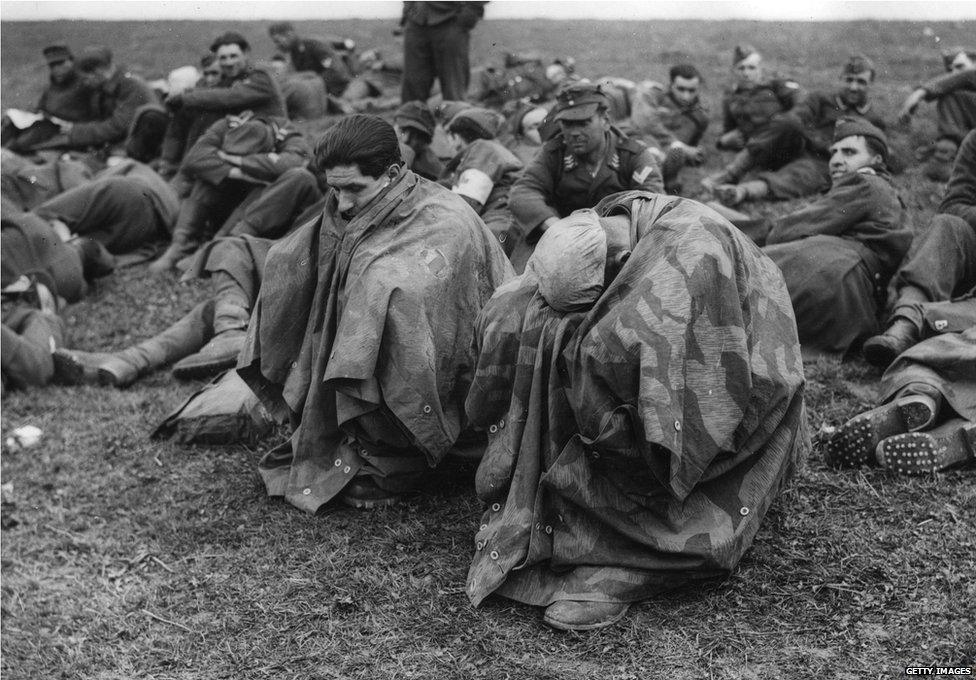
"I became a prisoner of war - a prisoner of the US Army. I finally got where I wanted to be!" he laughs.
"I was shipped off to a camp with 100,000 people there. I will never forget my first day behind barbed-wire fences. The most desolate day ever. There was nothing.
"There were no tents, no roof over our head. We were living out in the open.
"On the first day I said to the fellow in front, 'Hey you've got something crawling out of your collar!' He replied, 'You've got something crawling out of yours too!' We had lice."
Conditions slowly improved - latrines, water, and bread and spam to eat. Holtkamp began teaching himself English to become a translator and earn privileges.
"I learned four-letter words - every one you could imagine. And then one day, the British came in.
"They said, 'My God this is a terrible camp! Not the kind we keep for our prisoners.' They brought in tents and took care of us better. And ultimately - the British sent me home."
While he had been in the PoW camp, the Horst Wessel had become a war prize. The Allies were dividing up the spoils.
"My father told me the ship was in Bremerhaven. The whole town was totally bombed-out, but there was my ship.
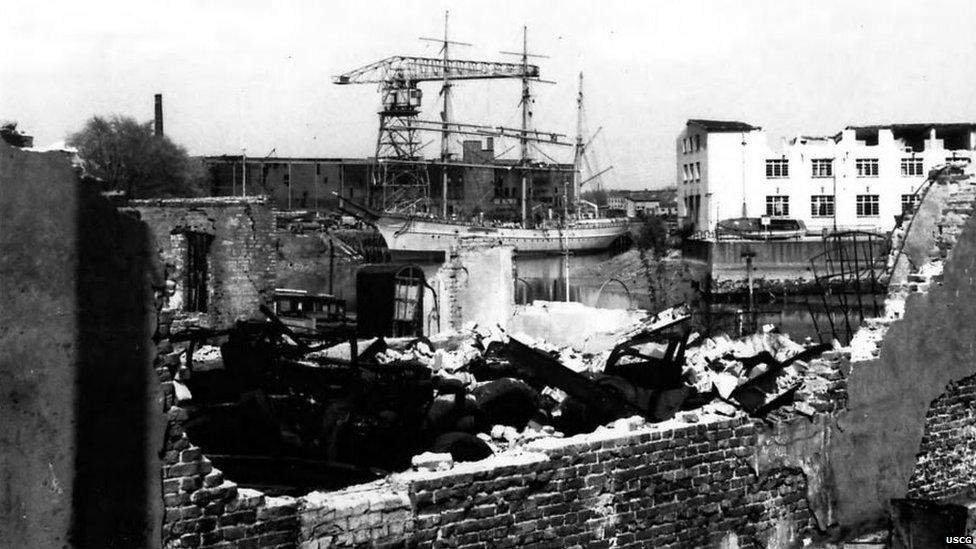
"And the captain - the SOB - he was still there, and he remembered me.
"He said: 'Holtkamp this is your opportunity! We need people to take the ship to an Allied port.'
"I said, 'Which port?' He said, 'Probably the Russians.' I said, 'No thanks! A nice trip to Leningrad and they'll ship me right back. Oh yeah, sure! I don't think so.'
"And that was the last time I saw the Horst Wessel. I waved her goodbye. "I was so sad about leaving her. We all were - my buddies and I. But I hoped to go on to greater things."
What none of them realised was the ship was not destined for Russia at all.
For Holtkamp, meanwhile, an opportunity soon came to emigrate to America - the land he had been so fascinated by.
It was 1949 and the US had just opened the border. "When I arrived in New York they kept asking me the same questions over and over. What did I think of Hitler? Was I in the Hitler Youth? What do I think of democracy?
"I said, 'If democracy is the same thing I went through in your prison camp I don't think I'm gonna like it.'"
He was surprised when, the following year, 1950, he received a draft notice for the US Army, signed by President Truman. His military days were not over after all.
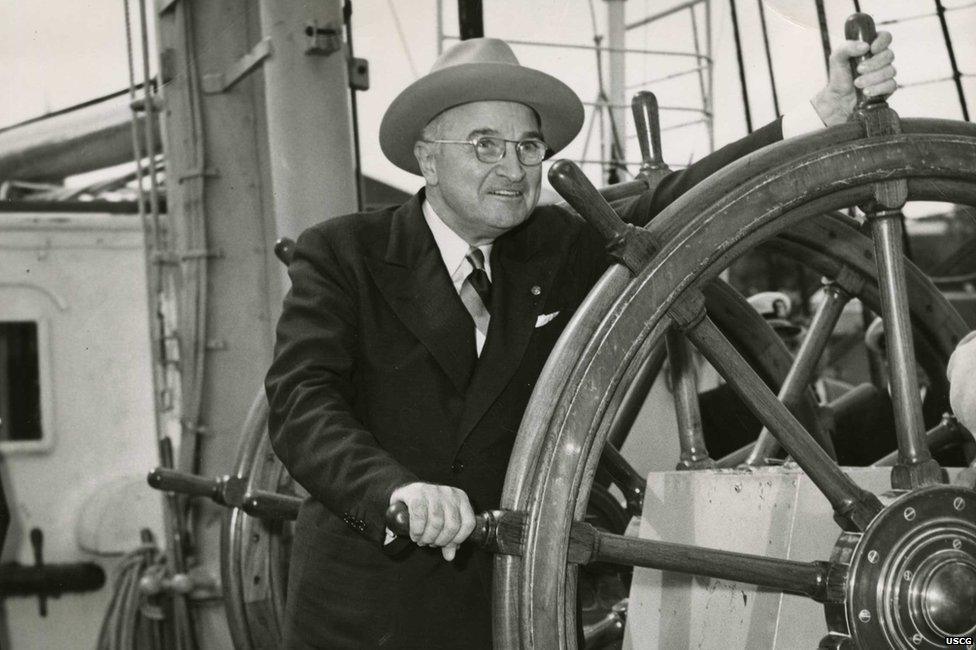
President Harry Truman at Eagle's helm, circa 1953
Holtkamp served two years for the US Army during the Korean War, before settling in Connecticut, where later that decade he enrolled in university.
"One Sunday afternoon in 1959 I took a young girl out for dancing. And on the drive back we came over the Gold Star Memorial Bridge. I looked down in the harbour and there I saw her. I knew immediately it was my ship.
"I said to my date: 'I'm sorry we can't go home yet!'"
When he arrived at the gates to the Coast Guard Academy some kind guards let him in - intrigued by his story and obvious enthusiasm.
"I went down to my old deck where I always slept and - guess what - there was a Coca-Cola machine."
So how had the Horst Wessel washed up in Connecticut?

Holtkamp has spent many years reconstructing the story, which he tells in his biography of the ship: A Perfect Lady.
It transpires that when the Allied commanders sat round the table in 1946 to divide up the spoils from the German fleet they did so by drawing names from a hat.
Three pieces of cardboard were folded up, popped in a cap, and the American, British and Russian commanders took their turns at lucky dip.
The Horst Wessel was indeed drawn by the Russian commodore. But secretly, under the table, he agreed a swap with the US officer - who was desperate to bring the tall ship back to the US.
And so in June 1946 an American crew, assisted by the original German captain and his remaining sailors, steered the newly rechristened Eagle from Bremerhaven, through an Atlantic hurricane, to New York.

USCGC Eagle
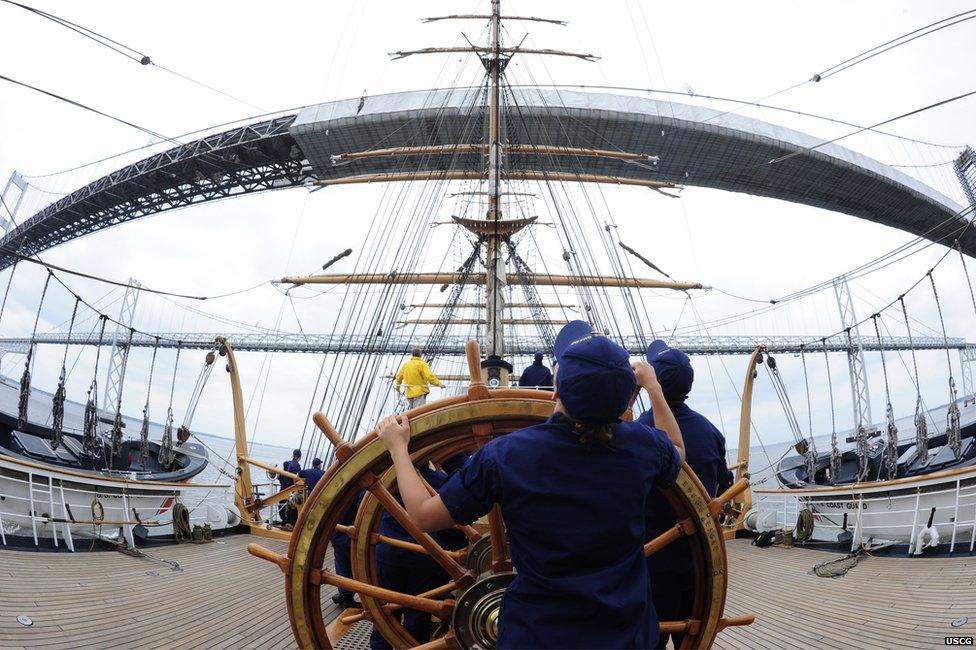
The tallest mast is 150ft - roughly equivalent to a 15-storey building
The ship is 295ft (90m) long - roughly equivalent to a football field
She weighs just under 1,655 tonnes - the hull and decks are made of steel
Has 23 sails measuring more than 22,000 sq ft, and six miles of rigging
Speed under full sail - 17 knots

Next year will be the 70th anniversary of this epic transit - and in celebration the Eagle is due to return to Germany.
She is undergoing a $28m (£18m) refit - from keel to crow's nest - in preparation for what is hoped will be another 70 years of active service.
Rather than a symbol of war she has become an emblem of peace and partnership between the two nations.
"When the Germans launched her back in 1936 they built her as a training vessel. And here we are 80 years later and it's doing the same great job they designed it for," notes Capt Cummings.
Join the US Coast Guard on board the Eagle
Over the years Holtkamp has become a frequent and welcome visitor to the academy in New London, having worked nearby at IBM for 28 years.
"I'm happy that the Coast Guard has the Eagle, because we used to be trained for war. But the Coast Guard is there to help people," he says.
"They take people off ships when they're sick. They rescue people. These things are good things - they're wonderful things.
"So I'm very happy that the Coast Guard has the Eagle. If I was a young man I think I'd join the Coast Guard too."
Videos by Colm O'Molloy
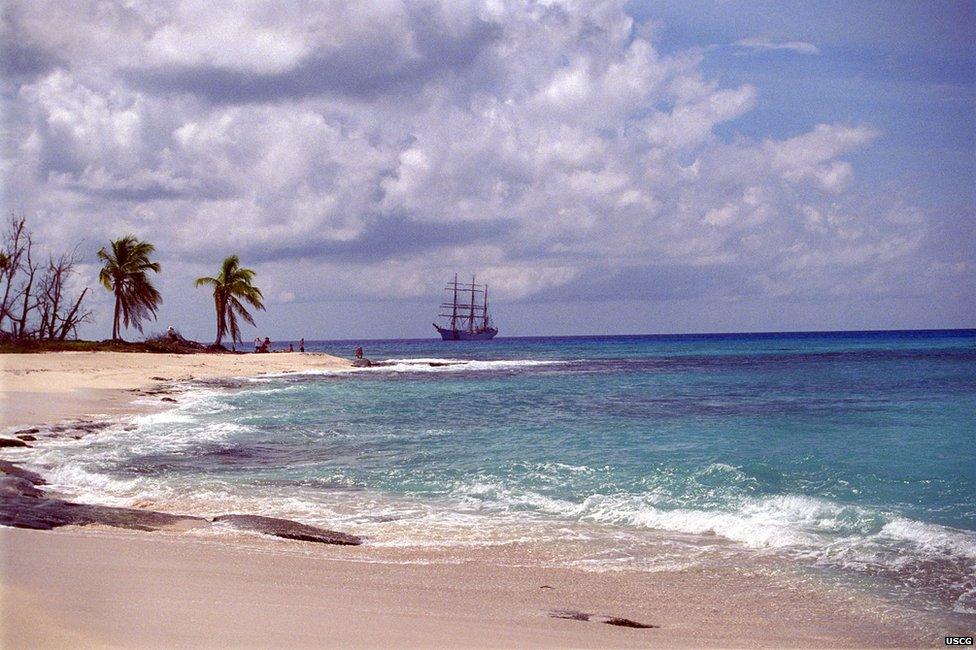
Subscribe to the BBC News Magazine's email newsletter, external to get articles sent to your inbox.
A selection of your comments:
I trained aboard Eagle as a US Coast Guard cadet from 1958-1961. I hated every minute. No sleep, not enough food, climbing aloft to furl sail, polishing brass, scrubbing bulkheads, holystoning the decks, standing watch in all weather or wiping grease in the engine room, sleeping in a hammock in a crammed compartment. A terrible experience. Now, at age 74, I read your story and tears came to my eyes. Oh to be aboard Eagle once again! Carl Burkhart, Brevard, NC, USA
My father Johann Bernard sailed on the Horst Wessel in WW2. He was a cook. He and a handful of German sailors took her from Gdansk Poland (where she had been moored for an extended time) back to Germany with the aid of a tug. The wheel was very hard to turn because of the lack of use. Later, after reaching it's destination, the sailors were told that they had gone through a mine field. Dad was a cook. He always remembered climbing to the top of one of the masts, just to see if he could do it. He passed away Saturday July 25th, 2015. Ralph Bernard, Marysville, WA, USA
I had the good fortune to make two European cruises on the Eagle as a cadet, once in 1951 and again in 1953. At the top of my lifetime experiences are memories of those voyages. It is the kind of experience you always remember but are happy you would never do again as a cadet. Yes, we learned a lot about the sea, but I also remember those cold, wet nights taking in sail during a storm and you hoped you grabbed the correct belaying pin to release the proper sail lines without benefit of light or sleeping in a hammock. Arthur J St. John, Chapel Hill, NC, USA
My aunt grew up in Berlin before WWII, and had a picture of Horst Wessel (or one of several sister-ships, which went to Poland, Russia, Portugal and Chile, I believe) at anchor with large Nazi flag. As a Coast Guard cadet, I sailed Eagle back to Germany for the first time, 1962 in Bremen, we wondered how we would be received ... People were very kind ... (I am one of the junior cadets waiting to 'pipe President Kennedy over the side' in your photo, that same summer.) There are experiences we share with others across the world: the fearful necessity of going aloft in a storm at night to take in sail; the weird vision of scores of sleeping hammocks keeping perfect harmony as the ship rolls and reacts to the waves; the view of port holes brought to the waterline as the ship sails, heeled over, looking like a window in a washing machine; the quiet, being aloft, having a fog bank below, seeing only your mast and others cutting through the sun-lit cloud below. It's the little things you notice, that seem so common when you're there and living it, that makes brothers of those who have the privilege of sailing these great ships. Wayne Becker, captain, USCG (retired), Moorestown, NJ, USA
Why shouldn't the US still use a tall ship built by the Nazis? There is a long and noble tradition of Navies capturing and renaming vessels and re-using them for their own purposes. I trained on the T.S. Foudroyant, which was built in Portsmouth between 1789 and 1798, but named after a French ship that had been captured from the French in 1758. Julius Marstrand, Cheltenham, UK
My father was stationed at the Coast Guard Academy during the second world war As a Lt. Commander. He told me that when the ship arrived in New London,they could not get it under the Gold Star Bridge and they we contemplating cutting the mast to get it under the bridge. Someone went down in bilge and found the mast was jacked up on blocks and could be lower. That allowed the ship to get under the bridge and be docked at the academy. John Taylor, Barrington, Rhode Island, USA
On [one] cruise on the Eagle, during which I had some free time, I was permitted to climb the ratlines to the highest yardarm (the royal) approximately 150 feet above the deck. As I got up on the yard I looked around in all directions. There were no other ships in sight and all I could see was where the horizon met the sky. As I looked straight down on the ship, it appeared to be about a foot long and a few inches wide. I suddenly realized how insignificant I was, and how this small vessel below me was all that kept me on the surface of this giant planet. Lewis Williams, Columbus, Ohio, USA
One of the best summers of my life was spent on her decks. 1st Class Petty Officer Grahm (BM1) was our SOB in 1991. A class mate was using the deck as a cutting board during marlinspike seamanship quals, BM1 cut into him, red-faced, veins popping with frantic hand gestures. After throwing the offending knife overboard he graphically describe what would happen to the lad if he put a knife to his deck again-- I don't think it was anatomically possible though... Chris Fritz, Ocean Springs, Mississippi, USA
In 1990, as a LT in EAGLE, we were in Rouen, France with many other tall ships for the bicentennial of Bastille Day. I gave a tour of EAGLE to some German cadets who had no idea EAGLE was once Horst Wessel. I was able to show them the original name plate. Under Capt. Dave Wood, EAGLE conducted a rescue mission entirely under sail while on a cadet training cruise. I happened to be serving as operations officer at the time. For the cadets, it was their first taste of search and rescue and proved to everyone that EAGLE was ready for any mission. No one could say for sure how long it had been since a USCG cutter had conducted a mission entirely under sail. Michael J. Sobey, Rural Retreat, Virginia, USA
My grandfather, Otto Christian Rudolph, was a sailmaker on the Eagle when he was in the German Navy. I'm not sure of the years since he was twice drafted into the navy. When the Eagle was in Philadelphia in 1976, we took him onboard and I think it was the happiest day of his life! He talked to all the staff for hours and had his shirt wide open to display his tattoo of the ship on his chest. We have lots of photos of him as a young man on the ship in different ports. We even have his ling curved needles that he used to sew the sails! Jo Walton, Glassboro, NJ, USA
In the summer of 1965, after leaving Acapulco, Mexico, Eagle slowed down near Baja California. We lowered the jabobs ladder, and an elderly man, walking with a cane came on board. Most of us didn't know who he was, there were no advance announcements. He was escorted to "officer country" and later that evening he came out on deck. By then we knew that the man was Walt Disney. He made his way around, one could see that he was not well, he stopped to talk to some cadets and crew members, and I was one of the fortunate ones. He told me that it was a childhood dream to be able to sail on a mighty Sailing vessel, such as the Eagle, a barque, or maybe a full rigger. The Coast Guard made Mr. Disney's dream come true. When we docked in San Diego two days later, he left waving good-bye to all of us. Edward Poian, Dobbs Ferry, NY, USA
In July of 1975 I was a brand new Coast Guard Academy cadet from Oklahoma sailing for my first time on the ocean on the Eagle. It was about 2am an there were 6 of us manning the three ships wheels used to steer the Eagle. The sky was covered with clouds, the wind was brisk and we were having rain squalls. Every sail was set and I could see a merchant ship about 3 miles ahead of us. Suddenly the clouds parted and the full moon sent a beam of light down that spotlighted the vessel. The white sails and hull had an unearthly glow as the whole ship lit up. I always wondered what the watchstanders on the other ship thought when the what appeared to be the ghost ship the "Flying Dutchman" suddenly came out of the storm in front of them. Steven Conway
My first sail station on EAGLE was on the royal yard on the foremast, outboard on the starboard side. Started out scared, and ended up loving it. I remember having to memorize every belaying pin on every rail so we could find blinded the one you needed - that that was before we ever saw, or boarded the ship. Learning every aspect of sailing a large ocean vessel teaches all about the environmental stresses offered ships as sea for wind, ocean, weather, why the Rules of the Road are so important. We learned navigation before there were satellites, and became skilled in meteorology mapping the weather, communications, how to takes orders and instructions when lives were on the line. All those skills are important on all ships - especially now in the age high technology. Sometimes the high tech stuff breaks, doesn't it? Capt James Rooney, Alexandria, VA, USA
Sailing off the US Atlantic coast in July, 1986, we were reefing the sails just before daybreak. My fellow cadets and I were on the topgallant yardarm, almost 150 feet above the water, pulling the sail up in the dim twilight. As the sun broke the horizon, we found ourselves in sunlight while the ship below us was still in shadow. Mesmerized by the beauty of the dawn, we looked down and saw dolphins playing in the bow-wake. Speechless, we simply looked at each other and smiled, and then got back to work. Peter Anderson, Broomfield, CO, USA
I remember we had to navigate by celestial the whole way from Panama to Bermuda. We succeeded at being within 5 miles of our true position upon our arrival at Bermuda which was a pretty cool achievement. My entire time on Eagle was like magic. There are small mementos of her German heritage all over the ship (we even got to use a sextant that was on display that head the Nazi eagle engraved on it). There is nowhere else in the world that duplicates the feeling of peace and accomplishment as when you are standing on a piece of rope 150 feet above the waves sailing silently through the ocean with just the sound of the wind in the rigging. An experience I will never forget and will cherish forever. Steve Schwartz, Toms River, NJ, USA
My father, Lt. Albert Frost, was in the U.S. Navy in 1946, stationed in Bremerhaven. He had been a navigation instructor at the Navy's Norfolk, VA base during the war, and was able to get himself assigned as the navigator aboard the Horst Wessel's first voyage as an American ship and war prize. Using a sextant, he charted the ship's course from Germany, across the Atlantic and around a hurricane to the US. Doug Frost, San Francisco, CA

Seven years ago, on a whale-watching trip out of Victoria, British Columbia, I was blown away by the sight of this magnificent barque progressing under full sail through the Juan de Fuca Strait. If ever there was a Coast Guard ship with attitude, this was it. Andrew Loudon, Wirral, UK